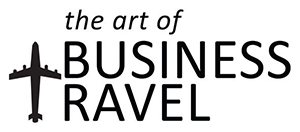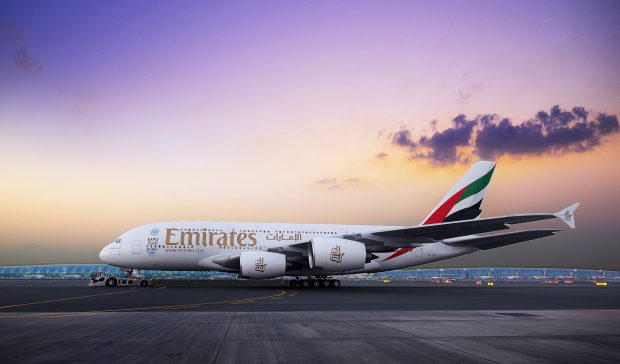
The Emirates A380s is synonymous with the lavish innovations the airline introduced as it filled its fleet with superjumbos. However, the human touch can still make or break a business class experience, discovers Nick Walton on a recent flight between Hong Kong and Bangkok.
Background
Dubai-based airline Emirates has long been the largest operator of the Airbus A380, ensuring a steady stream of travellers passing through its Middle Eastern hub. From Hong Kong, the airline operates both direct 777-300ER services and A380 services that travel via Bangkok.
Check-in/The Lounge
We checked in for our flight using Emirates user-friendly app and as we were travelling with carry on luggage only (Emirates offers business travellers 40kg of checked luggage and two carry on bags) we used our digital boarding passes to quickly pass through security and immigration at Hong Kong International Airport, taking the transit train to gate 40 and the signature Emirates lounge, located with a cluster of other airline lounges above gate 40.
READ: Qatar Airways Launches Quisine on China Routes
We’ve visited this lounge before and found it to be one of the better airline lounges at HKIA. Spacious and dressed in the airline’s signature caramel-toned leather, the lounge features single armchairs, café-style seating and a dedicated workspace.
Friendly staff welcomed us, advised us of our gate and boarding time, and directed us into the main lounge, which has a semi-alfresco feel because it’s open to the soaring ceilings of the airport concourse. The lounge overlooks the entrance to Cathay Pacific’s The Bridge airport lounge, as well as several HKIA restaurants.
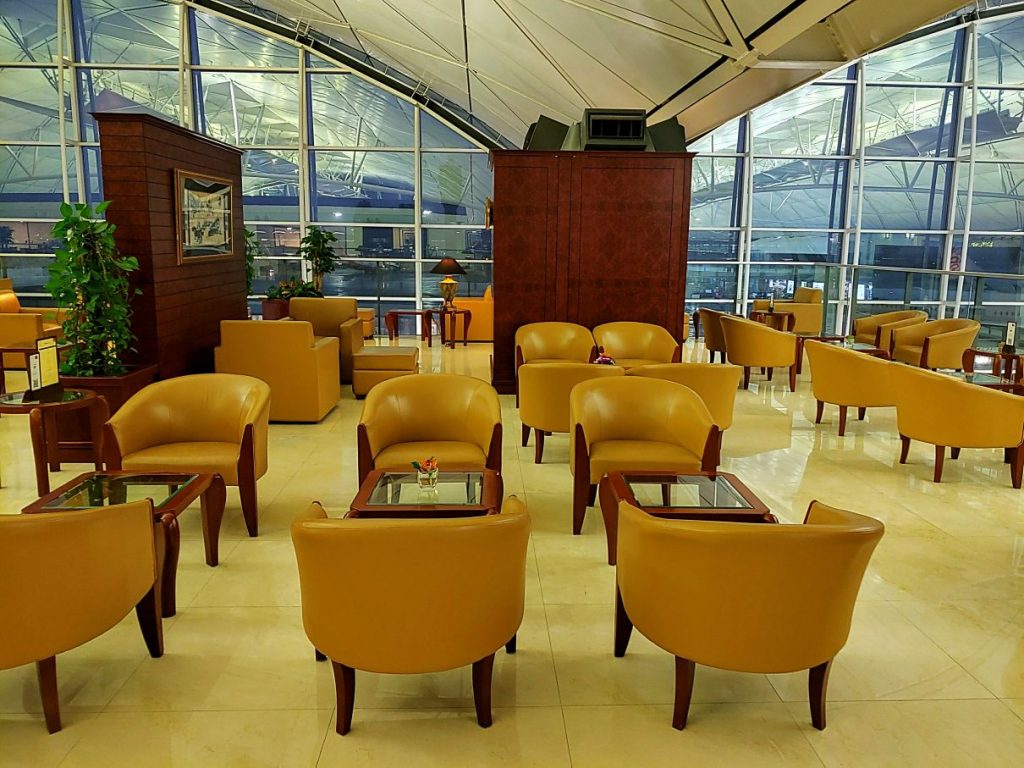
To one side is a hot buffet with a variety of impressive dishes on offer, ranging from beef medallions with grilled bell pepper; and barracuda with lemon butter sauce; to chicken thigh with honey and Pommery; and seafood fried rice. A cold buffet offers cold cuts, small salads and desserts, while a full bar set up finished the food and beverage offering.
We arrived to a virtually empty lounge, but the space quickly filled up as boarding time approached. Our previous niggle, that the lounge was very warm, wasn’t a factor this time during Hong Kong’s fleeting winter.
READ: Check Out Finnair’s New Nordic Cool Helsinki Lounge
Boarding
As you can imagine, boarding an A380 takes some planning – especially so with the A380 that Emirates flies to Hong Kong, which features just two classes, meaning a total of 557 economy class seats in addition to the 58 lie-flat business class seats. The process went relatively smoothly, although passengers using digital boarding passes – including us – had to have our passports re-scanned which took a minute or two. We entered the top level of the aircraft and passed through the upper economy class cabin to reach our seats in the rear, which means you’re nice and close to the Onboard Lounge (more about that in a moment).
The Seat
The first thing you’ll notice about the 18.5-inch wide business class seat on the A380 is how narrow it looks. My seat, 20A, was a window seat set against the bulkhead that divided the staggered business class cabins. Consequently, it had a block of bulkhead that jutted out and while it didn’t reduce any of the appeal of the seat once I sat down, it did make getting in and out a little tighter than I would have expected (although I quickly realized that actually all seats had a narrow exit to the aisle). However, once you do sit down, you realise the seat is perfectly comfortable and everything you need is close at hand.
READ: Four Points Debuts in KL
In the A380 business class cabin, which is staggered 1-2-1 (the middle seats are great for couples but the window seats with the seat closest to the cabin wall offer the most privacy), there are no overhead bins above the window seats. Instead window seats have storage spaces set into the windowsill, much like you’d find in a 747 upper deck. While they’re too narrow for most carry on luggage, they are handy for stowing away pillows and blankets.
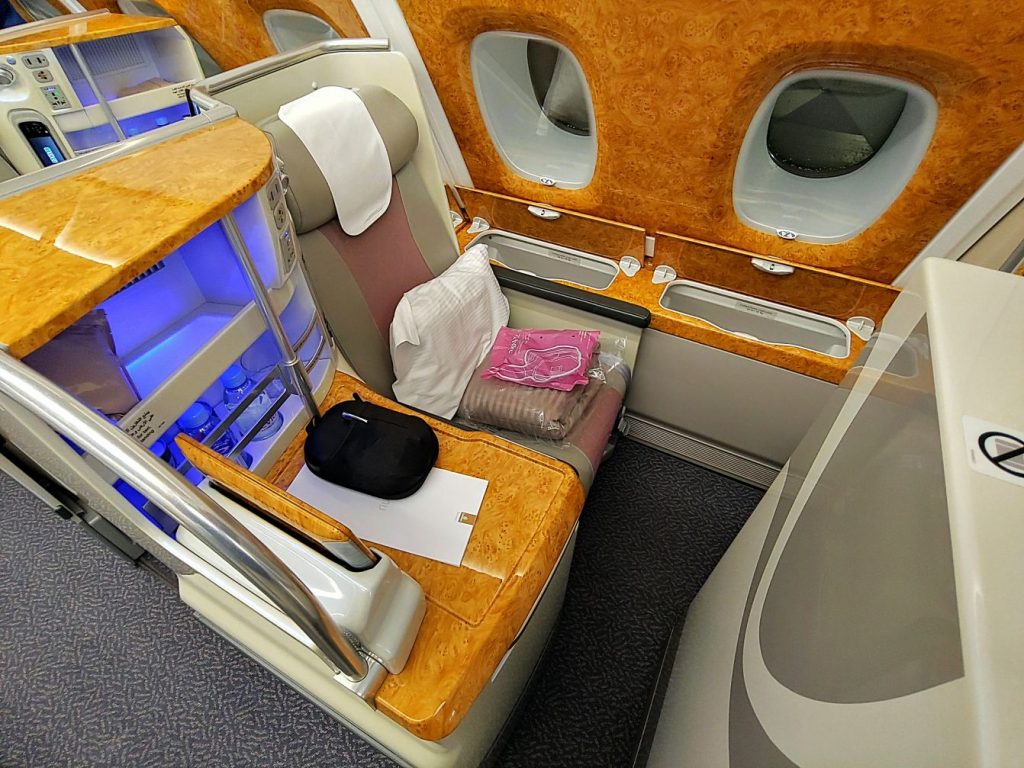
At shoulder level, a headphone jack and twin USB ports (a nice touch) and an AC outlet are easily reachable. Beyond, the seat’s ‘minibar’ (which is set behind rather crude stainless-steel bars) features bottles of water and soda, although they are room temperature so tend to be more of a fad than anything else.
A rather bulky (by today’s standards) tablet sits inside an electronically locked frame that releases it after takeoff; the tablet can be used to control the ICE monitor and seat position but after several attempts to navigate its menu ended in frustration, I leave it in its frame and simply reach forward to control the entertainment system on the monitor. Additional seat controls and yes, another remote and a personal reading lamp, can be found in the armrest and seat structure at shoulder level. Two air nozzles above the seat were a godsend. A pair of rather tinny Emirates branded headphones and an eye shade and socks were already provided, although I always use my own Bose QuietComfort 35IIs when I travel. I leave these amenity kits, filled with single-use plastics, alone these days but know that this little kit also includes stickers that indicate to crew when passengers would like to be woken – not really an issue on this route but a smart little feature.
The colour décor is warm and inviting but upon closer inspection, it’s a little plasticy, especially the accents made to look like maple. Two windows feature electronically controlled Venetian-styled blinds. In bed mode the seat was adequate, but the staggered style means the ‘hole’ in which your legs go can be rather tight if you have large feet. Unsurprisingly the airline tends to use this aircraft configuration on short to medium-haul services so it’s not so much an issue.
READ: FlyArystan Launches First International Service
After a long taxi to the western end of the airport, we took off, approximate 20 minutes after the stated departure time, with the pilot promising an on-time arrival in Bangkok. The Emirates A380 easily bumped and swayed its way through Hong Kong’s stormy weather as we flew south and then west.
Dining
Before takeoff, crew offered glasses of Moet Chandon Imperial Brut champagne, juice and water. I remember the days when it was little aspects like this – a common service offered across all business class cabins on most airlines – with which Emirates would subtly but effectively distinguish itself. For instance, Emirates once offered both brut or rose champagne pre-flight, but on this flight, drinks were dropped off with all the finesse of a harried milkman, with no smile, no personalization and no real attention to the task. This was followed by another, similarly disinterested young crew member, who took orders for dinner on a smartphone device.
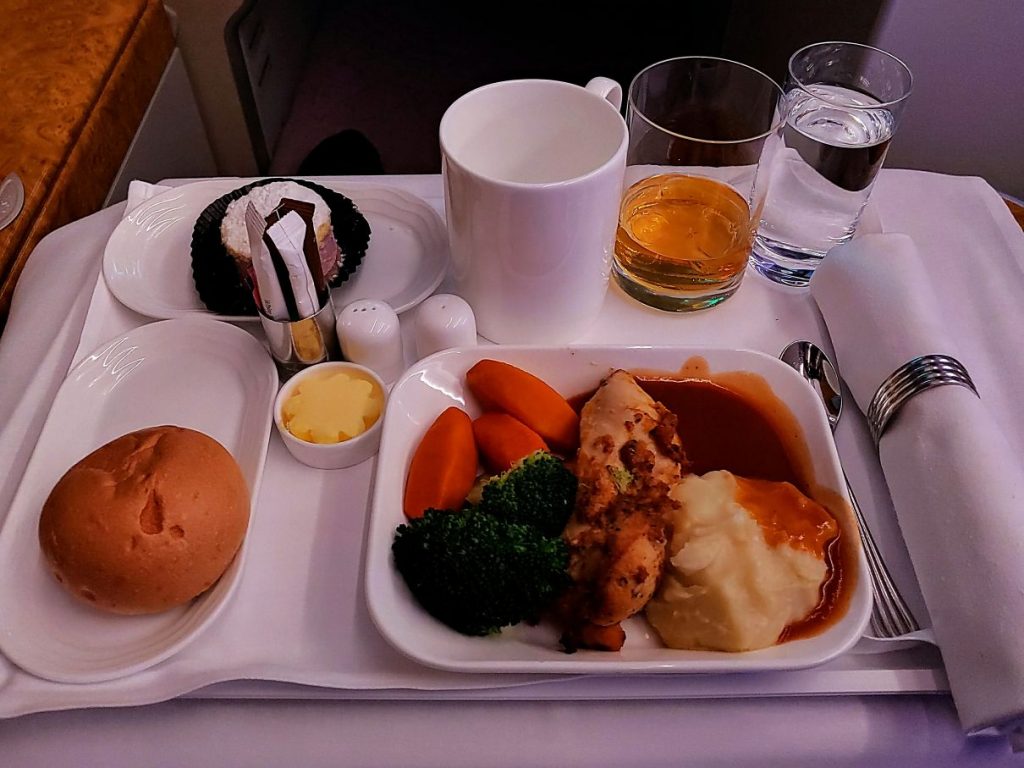
After the seatbelt sign was switched off and before the dinner service began, the crew took drink orders. Emirates has one of the most extensive drinks lists I’ve seen in business class, with a comprehensive range of cocktails – everything from Aperol Spritzers and Breakfast Martinis to Mojitos and Old Fashioneds – as well as a range of Scotch whisky (Chivas 18, Glenfiddich 15 and Jura Superstition), and a raft of other spirits. A separate wine menu included Burn Cotton Moonlight Race Point Pinot Noir from Central Otago, New Zealand; Chateau Cote Baleau Grand Cru; Pouilly-Fuisse Jean-Luc et Paul Aegerter 2018 from Burgundy; and Cloudy Bay’s famed Sauvignon Blanc. I opted for a Jameson Irish whiskey and soda, which at first arrived just as whiskey but was eventually rectified.
READ: AA Adds James Beard-winning Cuisine to Premium Cabins
On this short hop across Asia dinner started with mains, of which we were offered a choice of stir-fried prawns with ginger and lemongrass, egg noodles, and vegetables; and chicken with wild mushroom jus with steamed broccoli, pumpkin, and mashed potato with garlic. The chicken was plump and perfectly cooked although the service of the meal, all on one economy-styled tray perilously passed to me by a crew member who couldn’t reach through the gap between seat and bulkhead, left a lot to be desired. While the menu pointed out that Emirates flies to 140 destinations in 80 countries, and subsequently attempts to infuse a sense of the destination into its dishes, there was no sense of either Hong Kong or Bangkok in a stock-standard but perfectly adequate chicken and mash combo.
The menu also advised that additional snacks, including plastic-wrapped sandwiches, were available in the Onboard Lounge, which is where I headed as soon as the meal tray was cleared away. The two-class A380 is yet to benefit from the refreshed Onboard Lounge look that other super jumbos recently received but it remains an elegant space and the young bartender was only too happy to mix up a round of dry martinis. The new lounge concept features more seating and more selection but this space easily out tasked the sterile A380 lounge spaces you’ll find on the likes of Korean Air.
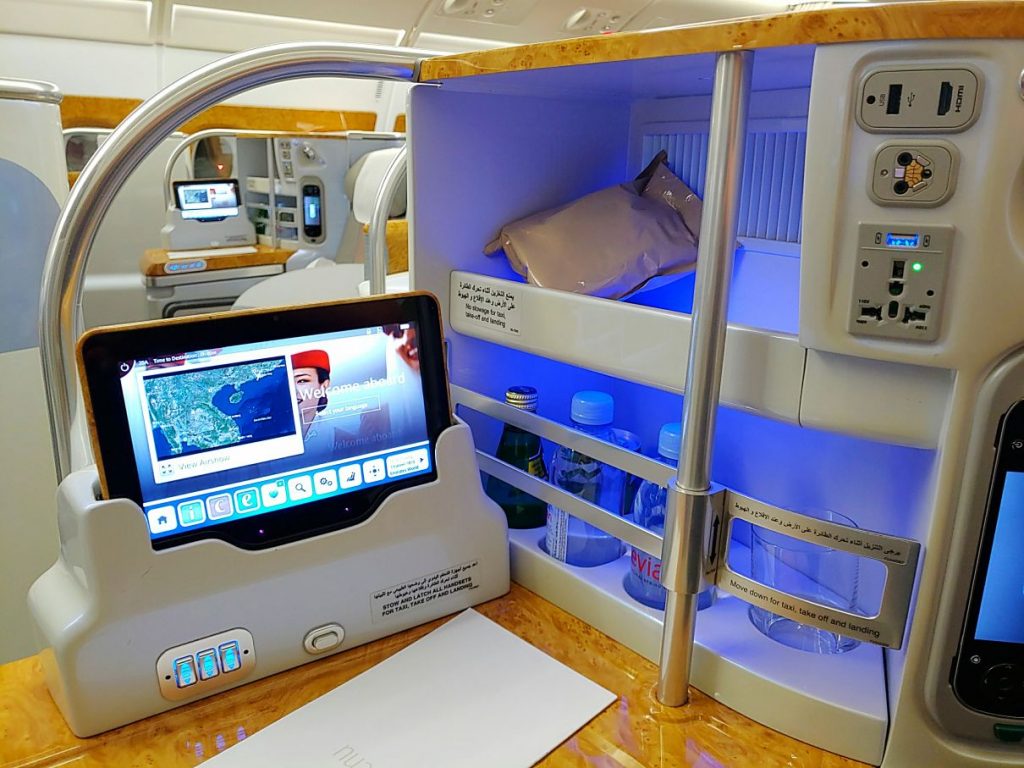
Entertainment
Emirates has won a bevy of well-deserved awards for its ICE (Information, Communication, Entertainment) inflight system. While the tablet, like the minibar, is more gimmick than practical, the system offered a wide selection of both blockbuster new releases and classic flicks – certainly enough to fly around the world a couple of times.
Service
My previous experiences with Emirates crew have always been good but the team on this particular flight were certainly not on their A-game. From disinterested crew at the aircraft door, to staff yawning through the safety briefing, to struggling dinner service and a noticeable absence of attendants the second dinner was over (they were all in the galley chatting about their holidays), it seemed the crew were in need of a shakeup, although I appreciate the 2-hour 30-minute flight between Hong Kong and Bangkok might not be the most titillating route. Unfortunately, as an airline that’s extremely marketing savvy, guests arrive onboard with certain expectations and on this flight, the service levels left a lot to be desired.
READ: 10 Predictions for the Airports of the Future
Summary
We touch down in Bangkok five minutes early, after a flight in which Emirates’ many ground-breaking innovations were evident and enjoyed, but also in which service that lacked structure or finesse left a rather sour taste in the mouth. Airlines are under pressure to meet traveller expectations and present the same levels of quality on short-haul international routes as they are on the flagship long-haul services. Despite very reasonable fares of late, on this particular instance, the Dubai carrier broke even at best.
Emirates Hong Kong-Bangkok in business class from US$327 per person.
Note: The author travelled on a full business class fare without the airline’s knowledge
Check Out Our Recent Reviews…
Airline Review: CX Business Class on the Airline’s Only Africa Route
Four Seasons Kyoto is a Modern Temple to Hospitality
Modern Australian in the Limelight in Hong Kong
